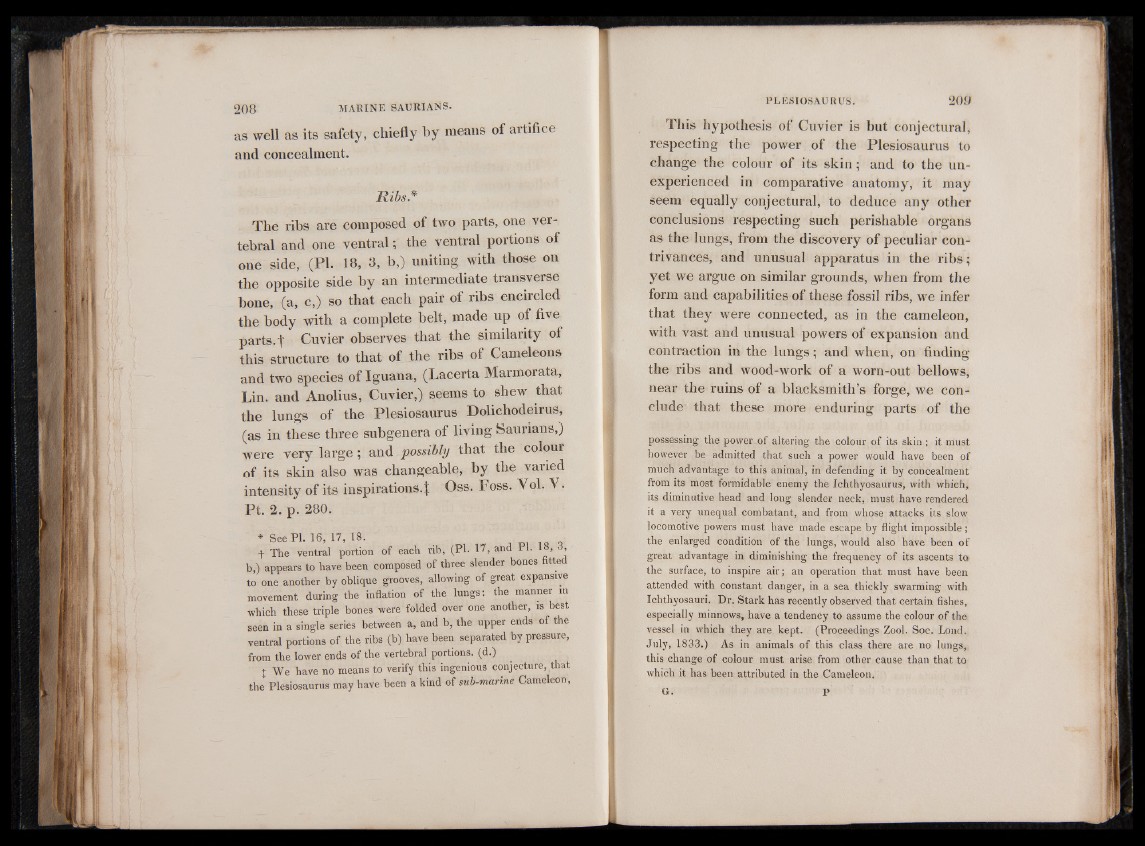
as well as its safety, chiefly by means of artifice
and concealment.
R ib s*
The ribs are composed of two parts, one vertebral
and one ventral; the ventral portions of
one side, (PI. 18, 3, b,) uniting with those on
the opposite side by an intermediate transverse
bone, (a, c,) so that each pair of ribs encircled
the body with a complete belt, made up of five
parts.f Cuvier observes that the similarity of
this structure to that of the ribs of Cameleons
and two species of Iguana, (Lacerta Marmorata,
Lin. and Anolius, Cuvier,) seems to shew that
the lungs of the Plesiosaurus Dolichodeirus,
(as in these three subgenera of living Saurians,)
were very large ; and possibly that the colour
of its skin also was changeable, by the varied
intensity of its inspirations.!; Oss. Foss. Yol. Y.
Pt. 2. p. 280.
* See PI. 16, 17, 18.
f The ventral portion of each rib, (PI. 17, and PI. 18, 3,
b,) appears to have been composed of three slender bones fitte
to one another by oblique grooves, allowing of great expansive
movement during the inflation of the lungs: the manner in
which these triple bones were folded over one another, is best
seen in a single series between a, and b, the upper ends of the
ventral portions of the ribs (b) have been separated by pressure,
from the lower ends of the vertebral portions, (d.)
X We have no means to verify this ingenious conjecture, that
the Plesiosaurus may have been a kind of sub-marine Cameleon,
This hypothesis of Cuvier is but conjectural,
respecting the power of the Plesiosaurus to
change the colour of its skin; and to the unexperienced
in comparative auatomy, it may
seem equally conjectural, to deduce any other
conclusions respecting such perishable organs
as the lungs, from the discovery of peculiar contrivances,
and unusual apparatus in the ribs;
yet we argue on similar grounds, when from the
form and capabilities of these fossil ribs, we infer
that they were connected, as in the cameleon,
with vast and unusual powers of expansion and
contraction in the lungs; and when, on finding
the ribs and wood-work of a worn-out bellows,
near the ruins of a blacksmith’s forge, we conclude
that these more enduring parts of the
possessing the power of altering the colour of its skin; it must
however be admitted that such a power would have been of
much advantage to this animal, in defending it by concealment
from its most formidable enemy the Ichthyosaurus, with which,
its diminutive head and long slender neck, must have rendered
it a very unequal combatant, and from whose attacks its slow
locomotive powers must have made escape by flight impossible;
the enlarged condition of the lungs, would also have been of
great advantage in diminishing the frequency of its ascents to
the surface, to inspire air; an operation that must have been
attended with constant danger, in a sea thickly swarming with
Ichthyosauri. Dr. Stark has recently observed that certain fishes,
especially minnows, have a tendency to assume the colour of the
vessel in which they are kept. (Proceedings Zool. Soc. Loud.
July, 1833.) As in animals of this class there are no lungs,
this change of colour must arise from other cause than that to
which it has been attributed in the Cameleon.
Gr. p